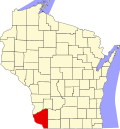Grant County, Wisconsin | |
|---|---|
 Grant County Courthouse, Armand D. Koch, architect, 1902 | |
 Location within the U.S. state of Wisconsin | |
 Wisconsin's location within the U.S. | |
| Coordinates: 42°52′N90°43′W / 42.86°N 90.71°W | |
| Country | |
| State | |
| Founded | 1837 |
| Seat | Lancaster |
| Largest city | Platteville |
| Area | |
• Total | 1,183 sq mi (3,060 km2) |
| • Land | 1,147 sq mi (2,970 km2) |
| • Water | 36 sq mi (93 km2) 3.1% |
| Population (2020) | |
• Total | 51,938 |
| 52,330 | |
| • Density | 45.6/sq mi (17.6/km2) |
| Time zone | UTC−6 (Central) |
| • Summer (DST) | UTC−5 (CDT) |
| Congressional district | 3rd |
| Website | www |
Grant County is the most southwestern county in the U.S. state of Wisconsin. As of the 2020 census, the population was 51,938. [2] Its county seat is Lancaster and its largest city is Platteville. [3] The county is named after the Grant River, in turn named after a fur trader who lived in the area when Wisconsin was a territory. [4] Grant County comprises the Platteville Micropolitan Statistical Area. It is in the tri-state area of Wisconsin, Illinois, and Iowa, and is crossed by travelers commuting to Madison, Wisconsin, from a number of eastern Iowan cities, and by residents of northern Illinois traveling to the Twin Cities or La Crosse, Wisconsin.
Contents
- History
- Indian presence
- Colonial period
- American period
- Geography
- Major highways
- Railroads
- Buses
- Airports
- Adjacent counties
- Demographics
- 2020 census
- 2000 census
- Government and infrastructure
- Politics
- Communities
- Cities
- Villages
- Towns
- Census-designated places
- Unincorporated communities
- Ghost towns/neighborhoods
- Notable people
- See also
- Footnotes
- Further reading
- External links


